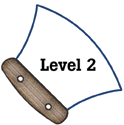|
National Science Education Standards
An object’s motion can be described by tracing and measuring its
position over time. (Page 127)
The Earth is the third planet from the sun in a system that includes
the moon, the sun, eight other planets and their moons, and smaller objects,
such as asteroids and comets. The sun, an average star, is the central
and largest body in the solar system. (Page 160)
Most objects in the solar system are in regular and predictable motion.
Those motions explain such phenomena as the day, the year, phases of the
moon, and eclipses. (Page 160)
|
|
Benchmarks
The patterns of stars in the sky stay the same, although they appear
to move across the sky nightly, and different stars can be seen in different
seasons. (Page 68)
Like all planets and stars, the Earth is approximately spherical in
shape. The rotation of the Earth on its axis every 24 hours produces the
night-and-day cycle. To people on Earth, this turning of the planet makes
it seem as though the sun, moon, planets, and stars are orbiting the Earth
once a day. (Page 63)
Planets change their positions against the background of stars. (Page
63)
The Earth is one of several planets that orbit the sun, and the moon
orbits around the Earth. (Page 63)
Stars are like the sun, some being smaller and some larger, but so far
away that they look like points of light. (Page 63)
|

